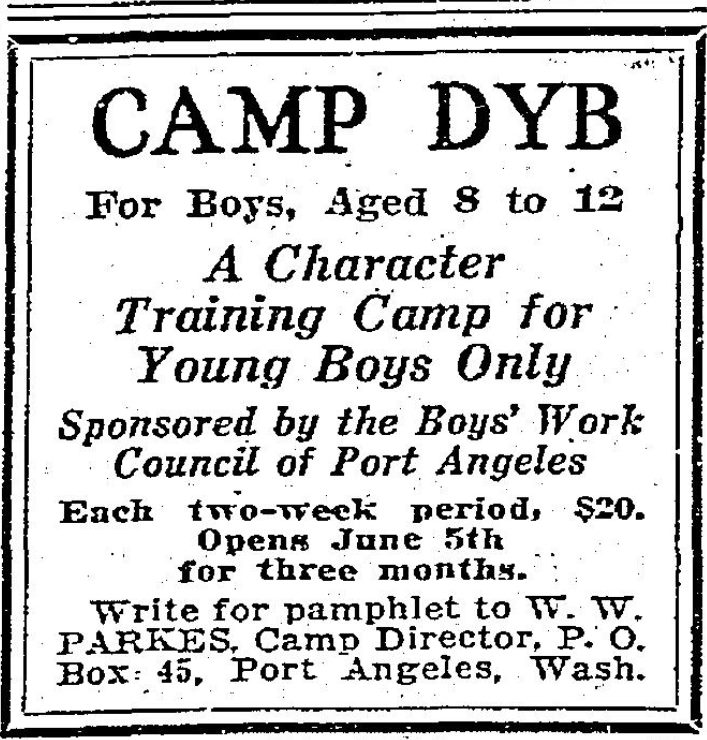Before there were officially Cub Scouts, the Seattle area had its first Cub Camp: Camp DYB or Camp Do Your Best.
(This article is the second in a series on the history of Cub Scouts in the Seattle area. See bottom of page for links.)
Introducing Camp DYB
Cub Scouts began in England in 1916 as Wolf Cubs, for 9-11 year old boys. By 1920 it had reached Victoria, the capital of British Columbia, Canada. Directly across the Strait of Juan de Fuca the city of Port Angeles was the first to adopt Cub Scouts in Washington State.
Sol Levy, organizer of the unofficial Wolf Cub pack at Port Angeles in 1923, started a summer Cub Scout camp for them nearby at the mouth of the Elwha River.
While “Be Prepared” is the famous motto of Scouts BSA (formerly Boy Scouts), the Cub Scout motto is still today “Do Your Best”. It serves dual purposes: first, youth should push themselves to do as well as they can; second, adults should realize these are still children and might not get it right the first time. Camp DYB provided a nine week summer session that could be registered in whole or in part, giving boys plenty of time to do their best.
BSA had a trademark on Scout, Scouting, and related terms, likely leading DYB to be advertised as a camp for “real boys”, rather than “Cub Scouts” or “Wolf Cubs”. Originally targeting boys age 8 to 11, the camp expanded eventually to ages 7 to 14.

Camp DYB activities
The Cubs had fun with activities like canoeing, hiking, archery, water slide, baseball, soccer, basketball, tennis, miniature golf, and overnight backpacking. All of the boys learned how to swim in the river and ocean, always with a buddy.
According to a 1928 Seattle Times article, the camp’s structures included a 62-foot long main building with kitchen, dining hall, offices, bathrooms, and residence for director W. W. Parkes; two 70-foot dormitories; a smaller dormitory; library; workshop; candy shop; medic building; lookout tower; 40-foot water slide; and a number of tent platforms. Parkes was an architect by profession, offering an easy explanation for all of the built structures of the camp.
Levy also wrote that he benefited from the camp: “As I look back on those years, I really gained a lot, for I was learning by doing.”

After Camp DYB
Camp DYB relocated near Bremerton in 1936. The new camp must have not offered the experience of the original at the mouth of the Elwha, though. The Seattle Area Council (now Chief Seattle Council) board began fundraising in 1937 to open their own dedicated Cub Scout camp. This opened in 1938 as Camp Meany, adjacent to Camp Parsons on Hood Canal.
There is some ephemera related to Camp DYB in the Bureau of Indian Affairs files at the National Archives in Seattle, such as the post card seen above. Also there is discussion of the camp and its facilities in material related to purchase of the property. Those are referenced in the National Parks Service’s interpretive history of the river. Hopefully this article can be updated with more details from them in the future.
The camp operated from 1924 to 1935, when the Bureau of Indian Affairs purchased the land to return it to the Elwha Klallam tribe. The site was adjacent to or over a former village site, and is now part of the Lower Elwha Reservation.

Further reading
- Cub Scouts began in Port Angeles (part 1 in this series)
- Wolf Cubs lost at war (part 3)
- Blue Ox Camp, Seattle’s Paul Bunyan themed camp (part 4)
- What did they sing at Blue Ox camp? (part 5)
- Cub Scout Alphabet
Also:
- The Start of Scouting in Seattle
- Seattle’s first patrol leaders
- Seattle’s first Eagle Scout
- Elmer Katayama at Camp Parsons opening
- George Nakashima and Scouting
Discover more from ba-kground
Subscribe to get the latest posts sent to your email.
